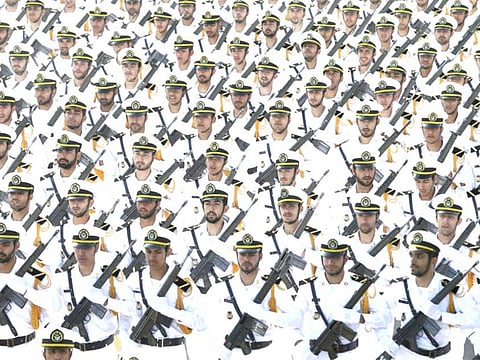Iran spurs regional arms race
Tehran’s expansionist designs have paved the way for stockpiling of weapons in the Middle East

Saudi Arabia and Iran are arguably the major powers in the Middle East if you ignore Israel. And the power comes from their military prowess. Iran’s adventurism in Syria, Lebanon, Iraq and Yemen has turned up the heat in the Arab world forcing Saudi Arabia to react strongly in Yemen. Iran is not averse to displaying its military power. During Iran’s Army Day there was a parade of military hardware including various defence systems, ballistic missiles, Unmanned Aerial Vehicles (UAV), planes, tanks, armoured vehicles and command-and-control combat systems.
Some of these are indigenously-made such as the Aftabaz passive radar as well as the Kamin 2 and Seraj 1, S-300 and S-200 missile systems as well as other military apparatus.
President Hassan Rouhani was quoted as saying Iran “would produce or acquire any weapons we need” without the approval of the world, which is a clear snub to the world powers. “We are surrounded by aggressive world powers who intervene in the region’s affairs in defiance of international law and invade countries without the consent of the UN and against its charter,” he said. But he quickly sought to allay the concerns of the states in the region, saying: “Our weapons are not against you. It’s for deterrence.”
The regional powers don’t seem to have taken in by the talk of deterrence, fully aware of Iran’s expansionist ambitions. Tehran has repeatedly sought to spread its influence in the region, so the Arab states are very wary of its designs. Israel had started the arms race in the Middle East long ago, and Iran has only accelerated the proliferation of weapons in the region. Iran’s arsenal and its hegemony has forced Saudi Arabia to buy weapons to ward off the threat.
Israel upset the balance of power in the region with huge handouts of money and weapons from the United States. Iran, not to be undone, beefed up its military hardware with domestic production. Global sanctions over its nuclear research didn’t hold back Tehran, which used its oil wealth spread its tentacles in the region. Hezbollah in Lebanon, various factions in Iraq, President Bashar Al Assad in Syria and the Al Houthis in Yemen benefited enormously from Iran’s weapons largesse. The result is instability in the region.
Unrest in the region and its neighbourhood prompted Saudi Arabia to upgrade its weapons stockpile and hone its military skills with joint Gulf military exercises. The Iran-backed Al Houthis across the border in Yemen were always an irritant. But matters came to a head when the rebel militia illegitimately seized power. Leading an Arab coalition, Saudi Arabia ousted the Al Houthis from Aden, and the militia has been on the retreat ever since.
An arms race is inevitable in a region beset by wars. The last shot is yet to be fired in Yemen and Syria. Israel has churned the troubled waters with occasional forays into Syria, where the Iranians and Russian prop up the Al Assad regime. One of their air raids hit the Iranian military camp in Syria and Tehran has not taken it kindly.
If a war breaks out between Iran and Israel, the region will be on fire. There’s enough arsenal in the Middle East. The United States, Russia, China, Britain and France have ensured that.
Marwan Asmar is a commentator based in Amman. He has long worked in journalism and has a PhD in Political Science from Leeds University in the UK
Sign up for the Daily Briefing
Get the latest news and updates straight to your inbox



